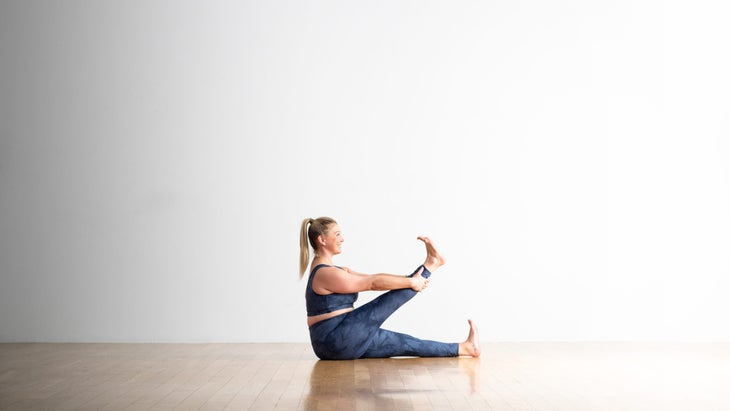Heading out the door? Read this article on the new Outside+ app available now on iOS devices for members! Download the app.
Vyasa, Patanjali’s oldest extant commentator, mentions this pose, though he doesn’t describe how to do it: “The curlew and other seats [asana] may be understood by actually seeing a curlew and the other animals seated” (Yoga Sutra 2.46). A curlew is a brown bird with long legs.
Sanskrit Name
Krounchasana (crown-CHAH-sana)
Kraunch can mean crane, heron, or long-legged water birds.
Heron Pose: Step-by-Step Instructions
- Sit in Dandasana (Staff Pose). Bring your left leg into Ardha Virasana. Then bend your right knee and place the foot on the floor, just in front of the right sitting bone. Place your right arm against the inside of the right leg (so that your shoulder presses against the inner knee). Cross your hand in front of the right ankle and grasp the outside of the right foot. Finally grasp the inside of the right foot with your left hand.
- Lean back slightly, but keep the front torso long. Firm the shoulder blades against your back to help maintain the lift of the chest. Inhale and raise the leg diagonally to the floor, angled about 45 degrees, or with the foot as high as or slightly higher than your head.
- Hold this position for 30 seconds to a minute. Then exhale and release the raised leg. Carefully unbend and straighten the left leg (see the description of Virasana [Hero Pose] for the safe way to remove the leg from its position). Repeat with the legs reversed for the same length of time.
Variations
Heron with straight legs

If you have difficulty doing this pose with one leg in Ardha Virasana (Hero Pose), keep that leg straight as shown above, or bend it and open it out to the side as in Janu Sirsasana.
Heron with a strap

Many beginning students won’t be able to completely straighten the raised leg or will lose the lift of the chest when attempting to do so. To counter this, place a strap around the sole of your foot before you try to straighten the leg. Hold the strap as close to your foot as possible, keep your elbows fully extended and keep your chest lifted.
Deepen the Pose
Advanced students can increase the stretch on the back of the raised leg by bringing the leg and torso together. From the position described in step 2 above, bend your elbows sharply out to the sides, lean the torso slightly forward, and draw the leg in. Be sure to keep the front of the torso relatively long; don’t lean forward from the belly.
You can add a twist to this pose. First perform Krounchasana. Then take the outside of the raised leg with the opposite-side hand (turn the thumb down toward the floor), and press the same-side hand on the floor behind you. Exhale and swing the leg slightly to the opposite side (i.e., when the right leg is raised, swing it to the left); at the same time, twist the torso toward the raised leg. Hold for 15 seconds or so. Release the twist as you exhale, return the hands to their original grips on the foot, and lower the raised leg to the floor.
Partnering
Have your partner sit (or kneel) in front of you as you perform the leg position for Krounchasana. Support your torso by pressing your hands on the floor, just beside your hips. As you begin to lift the right leg off the floor, have your partner take the heel. Now straighten the bent knee again, as your partner begins to carefully lift your foot away from the floor. Start off slowly and move the leg higher by degrees. Continue pushing your hands against the floor to keep your torso lifted. Stop moving the leg when you feel a comfortable stretch, regardless of how high the foot may be. Wait a few breaths, then see if you can further lift the leg while keeping your torso upright.
Pose Information
Benefits
- Stretches the hamstrings
- Stimulates the abdominal organs and heart
Contraindications and Cautions
- You may choose not to practice during menstruation
- If you have any serious knee or ankle problems, avoid the Ardha Virasana (Half Hero Pose) leg position in this pose unless you have the assistance of an experienced instructor. Instead sit with the legs positioned in Janu Sirsasana (Head-to-Knee Forward Bend)
Beginner’s Tip
Practice Virasana regularly to prepare your thighs for the full Krounchasana.
Preparatory Poses
Adho Mukha Svanasana
Baddha Konasana
Dandasana
Janu Sirsasana
Paschimottanasana
Siddhasana or Sukhasana
Supta Padangusthasana
Uttanasana
Utthita Parsvottanasana
Virasana
Follow-up Poses
Krounchasana is usually performed as part of a longer seated forward bend sequence. In a typical Iyengar or Ashtanga sequence it’s usually followed by poses like Marichyasana I (Marichi’s Pose), Upavistha Konasana (Seated Wide Angle Pose), and Paschimottanasana (Seated Forward Bend).